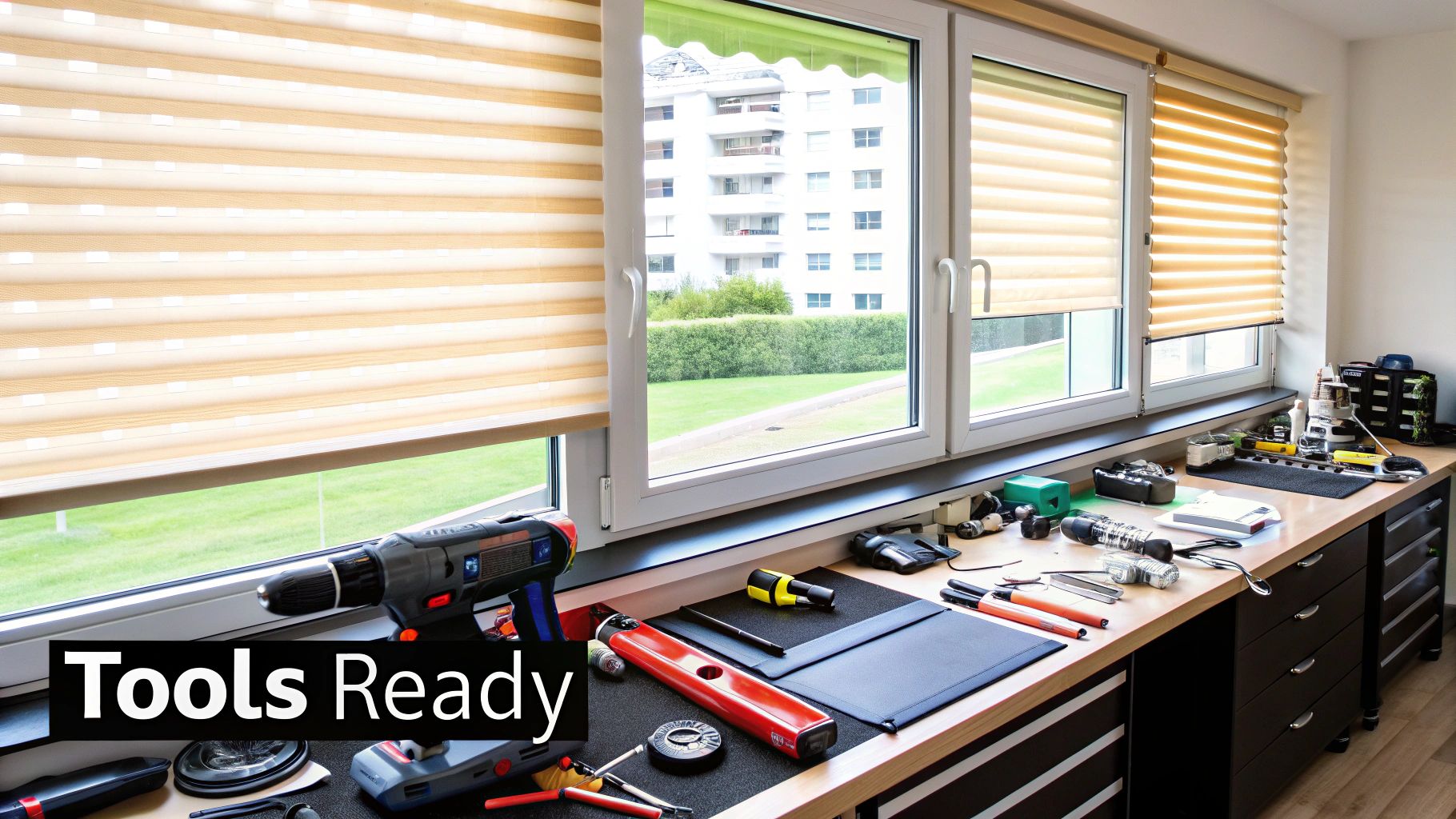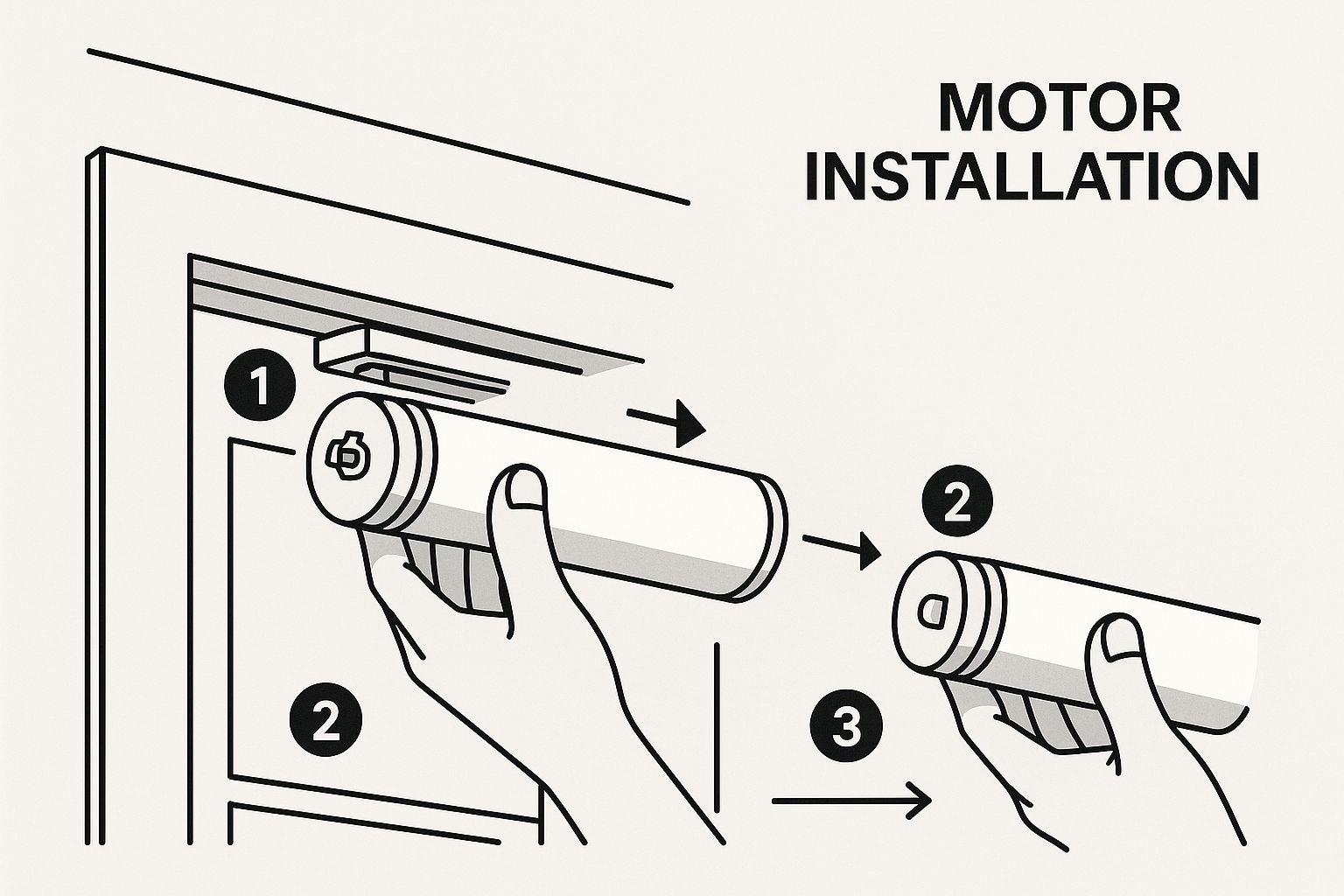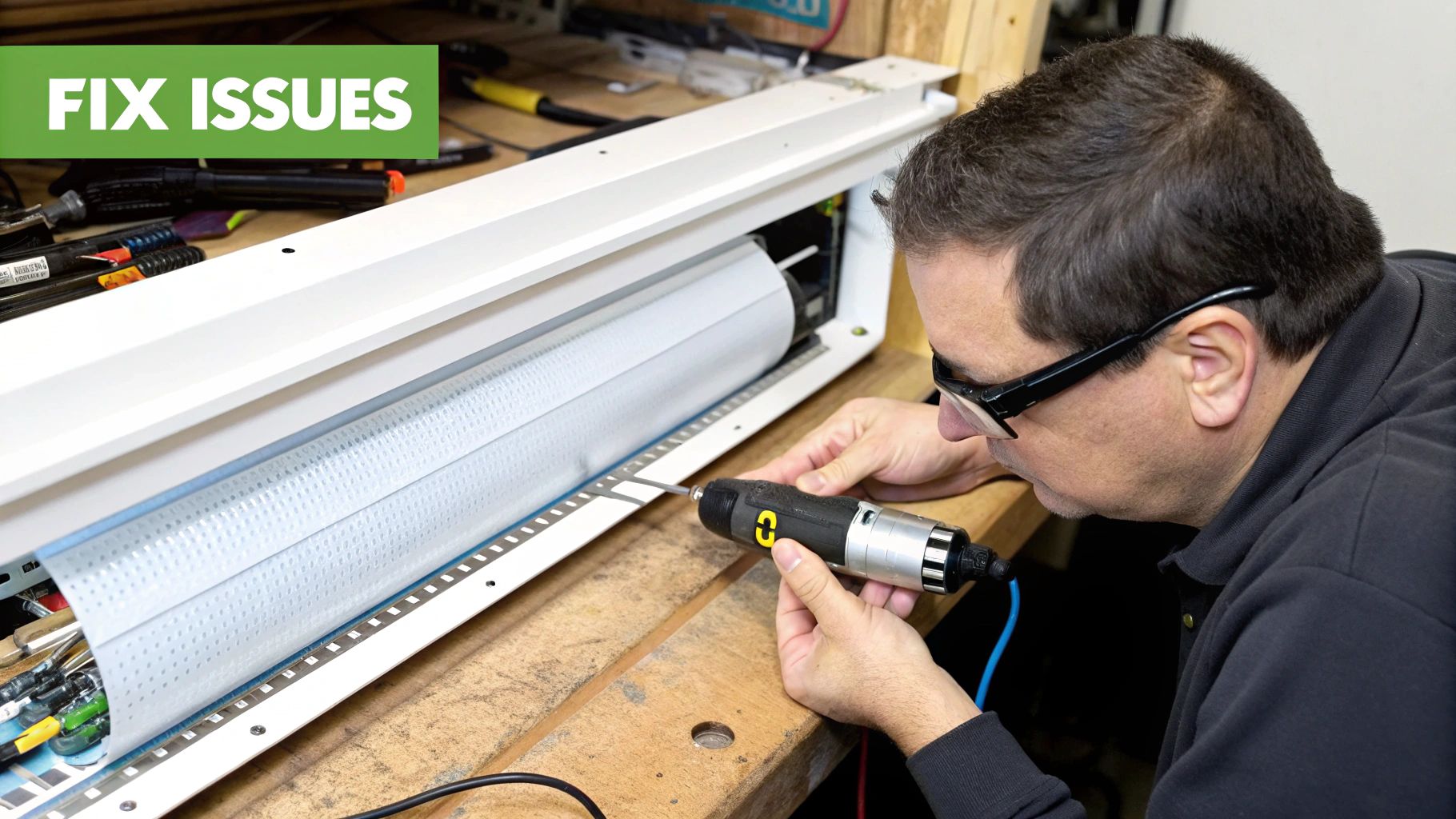Motorized Blinds DIY: Complete Installation Guide
- Johann Reardon
- Jul 18
- 13 min read
Getting Started Without The Overwhelm
DIY motorized blinds. The very idea might conjure images of tangled wires, specialized tools, and a feeling of complete bewilderment. But the truth is, it's much less intimidating than you might think. Thousands of homeowners successfully install motorized blinds every year, making their homes smarter and more comfortable. You can do it, too! This section provides the essential foundation for a successful DIY project, helping you avoid common mistakes and build the confidence to make your vision a reality.
Assessing Your Skills and Choosing the Right System
The first step is honestly assessing your DIY abilities. Are you comfortable with basic wiring? Do you have some experience using power tools? You don't need to be a licensed electrician, just aware of your comfort level. A battery-powered system might be perfect for beginners, while someone with more electrical experience could consider a hardwired setup. Check out our guide on Unveiling the Future: Motorized Blinds and Shutters Revolutionize Home Innovation for more information about different systems.
The rising popularity of motorized blinds reflects this growing DIY confidence. The market is expanding rapidly. The Electric Blinds and Shades Market is expected to reach approximately USD 3.25 billion by 2033, with a CAGR of 4.4%. This growth is driven by the demand for convenient, secure, and energy-efficient homes. You can find more statistics here. This increased demand means more readily available resources and user-friendly products for DIY enthusiasts.
Gathering Your Tools and Taking Accurate Measurements
Next, gather your tools. Don't worry about incredibly long lists; stick to the essentials. You'll need a drill, screwdriver, level, measuring tape, and possibly a voltage tester for hardwired systems. Don't buy unnecessary tools based on marketing hype. A good quality basic set is often sufficient.
Accurate measurements are vital. Think of it as baking – incorrect ingredients or quantities spell disaster. Measure your windows twice, even three times, for accuracy. Record the width and height at several points, as windows can be slightly uneven. This careful approach will ensure you order the correct size and avoid future problems. You might find this helpful: How to master window measurements.
Power Considerations and Seeking Professional Help
Finally, think about your power source. Battery-powered systems are easy to install but need occasional battery changes. Hardwired options offer continuous power but require electrical work. If you're unsure about any part of the electrical installation, consult a qualified electrician. Safety should always be your top priority. Knowing when to seek professional guidance is a mark of a wise DIYer, not a sign of weakness. Even experienced DIYers get help with specific tasks sometimes. This collaborative approach often leads to the best results.
Choosing Your Perfect Motorized Blind System

Now that you have a grasp of the fundamentals, let's explore the core of your motorized blinds DIY project: choosing the right system. This decision significantly impacts installation, daily use, and overall satisfaction.
Power Source: Battery vs. Hardwired
One of your first decisions involves selecting between a battery-powered system and a hardwired system. Battery-powered blinds offer easy installation, avoiding electrical work. This makes them perfect for DIY beginners.
However, batteries need occasional replacement. Blinds in high-use areas may require more frequent changes. Hardwired systems provide continuous power, eliminating battery replacements.
Installation, however, requires electrical wiring, potentially needing professional help if you're not comfortable with electrical work.
Control Options: Remote vs. Smart Home Integration
Consider your preferred control method. Remote controls provide a simple, reliable way to adjust blinds. This suits those wanting a straightforward approach. Some prefer remotes, avoiding broader smart home system integration.
Smart home integration offers more automation and convenience. Control blinds with your smartphone, schedule adjustments, and integrate with voice assistants like Alexa or Google Home. Automate opening and closing based on time or sunlight.
Material Considerations and Budget vs. Features
Blind material affects motorization compatibility. Heavier materials, like wood blinds, may need stronger motors. Choosing the right motor ensures smooth operation and longevity. Learn more about material selection in our article on How to master window treatment selection.
Balancing budget and features is key. Advanced systems offer more customization but cost more. Prioritize features aligning with your lifestyle and budget. A basic system might suffice for simple light control. A more advanced system may be necessary for smart home integration.
To help you choose the right system for your needs, take a look at the comparison table below:
Motorized Blind System Comparison Compare different types of motorized blind systems including power source, installation complexity, cost, and best use cases
System Type | Power Source | Installation Difficulty | Cost Range | |
|---|---|---|---|---|
Battery-powered DIY Kit | Battery | Easy | $50-$200 per blind | DIY beginners, renters, small projects |
Hardwired DIY Kit | Hardwired | Moderate | $100-$300 per blind | Homeowners comfortable with basic wiring, medium-sized projects |
Smart Home Integrated System (Battery) | Battery, Rechargeable | Moderate | $200-$500+ per blind | Smart home enthusiasts, convenient automation |
Smart Home Integrated System (Hardwired) | Hardwired | Difficult | $300-$600+ per blind | Large homes, complex setups, seamless integration |
This table provides a quick overview of the different motorized blind systems available, allowing you to easily compare key features and costs. Remember to consider your individual needs and budget when making your final decision.
DIY Kits vs. Advanced Systems
Finally, choose between DIY kits and advanced systems. DIY kits provide a user-friendly, cost-effective way to motorize existing blinds. They typically include everything needed for basic installation.
Advanced systems offer more features and customization but can be complex to install. Some allow individual blind control within a group, ideal for large windows or sliding doors. These systems offer flexibility for future expansion and integration with other smart devices.
Carefully consider the balance between ease of installation and desired customization. This ensures a successful motorized blinds DIY project that fits your needs and enhances your home.
Essential Tools and Materials That Actually Matter
Forget those incredibly long tool lists that make DIY motorized blinds installation seem overwhelming. This section simplifies what you actually need, based on real-world experience from many DIYers. We'll help you separate the essential tools from the optional ones, allowing you to budget wisely.
Must-Have Tools for Motorized Blinds DIY
Some basic tools are absolutely necessary for a smooth installation. A high-quality drill, for instance, is key for attaching brackets to your window frame or wall. Invest in a drill with multiple speed settings and a solid chuck to prevent slippage. A set of screwdrivers with different head types (Phillips, flathead, etc.) is also essential. The correct screwdriver will prevent stripped screws, a common installation problem. You'll also need a level to ensure your blinds hang straight. A small torpedo level or a longer carpenter's level will work, depending on the window size. Finally, a measuring tape, preferably a retractable steel one, is crucial for accurate measurements—precision is important for a successful outcome.
Nice-To-Have Tools and Budget-Friendly Alternatives
While not strictly required, some tools can make the job easier. A stud finder can help locate wall studs for secure mounting, particularly with heavier blinds. If you don't own one, tapping along the wall and listening for a change in sound can often help locate studs. A pencil or marker is useful for marking drill holes and bracket positions. A drill bit set with various sizes can also be handy, though many motorized blind kits include the required hardware.
Mounting Hardware and Safety Equipment
The correct mounting hardware is essential for various window types and wall materials. Most motorized blinds DIY kits include standard brackets, but you may need specific ones for unusual windows. Always refer to the manufacturer's instructions for specific recommendations. Safety should always be a priority. Safety glasses will protect your eyes from dust and debris while drilling. A stable stepladder is a necessity when working at height. For hardwired systems, a voltage tester is essential to ensure the power is off before any electrical work begins.
Essential Accessories and Insider Tips
Experienced installers often use small accessories rarely mentioned in instructions. Shims can be incredibly helpful for leveling blinds on uneven surfaces. Small plastic cable clips help manage extra wiring. For accurate measurement tips, you might find this helpful: How to master window measurements.
Having the right tools and a basic understanding of the process will make your motorized blinds DIY project much more enjoyable. The next step is understanding the installation process, which we'll discuss in the following section.
Your Step-By-Step Installation Roadmap
This guide simplifies the process of installing motorized blinds, breaking it down into easy-to-follow steps. From initial preparation to final testing, we'll be with you every step of the way.
Preparing For Installation
First, gather all the necessary tools and materials. Organize them for a smoother workflow. Clear the area around your window, covering any nearby furniture to protect it from dust. For hardwired systems, turn off the power at the breaker box to prevent electrical shocks. This is a crucial safety precaution.
Mounting the Brackets
Accurate bracket placement is essential for your blinds to function correctly. Measure carefully and use a level to mark the bracket locations on the window frame or wall. Pre-drilling pilot holes can prevent cracking, especially with harder materials like wood or metal. Secure the brackets using appropriate screws, making sure they sit flush against the surface. The infographic below illustrates how to install the motor into the headrail before mounting.

This image demonstrates the precise process of integrating the motor into the headrail. Correct alignment is key for smooth operation. Securely attaching the motor within the headrail will prevent issues down the line.
Installing the Motorized Mechanism
Carefully attach the motorized mechanism to the headrail, following the manufacturer’s instructions. This usually involves connecting wires or inserting batteries. Handle these components with care to avoid damage. After securing the mechanism, do a quick function test before final installation. This confirms it’s working correctly. For battery-powered blinds, place the battery pack in an accessible yet discreet location, perhaps inside the headrail or on a nearby wall.
Mounting and Aligning the Blinds
With the motorized mechanism in place, mount the headrail onto the brackets. Make sure the blinds hang level and move smoothly along the track. Most systems include adjustment screws for fine-tuning. Take your time with this; properly aligned blinds look better and operate more effectively.
Wiring and Powering Up (For Hardwired Systems)
For hardwired systems, carefully connect the wires from the motorized mechanism to the electrical wiring in your wall. Secure the connections with wire nuts and tuck them neatly into the wall box. Consult a qualified electrician if you have any doubts about electrical work. Safety is paramount. After wiring, restore power at the breaker box and test the blinds.
Testing and Troubleshooting
Test the blinds thoroughly, checking their full range of motion, including opening, closing, and tilting. Listen for any unusual noises or look for obstructions. Most systems have a manual override for power outages. Learn how this feature works. If you encounter any problems, check the manufacturer’s instructions for troubleshooting tips. Many common issues have easy solutions.
Battery Placement (For Battery-Powered Systems)
For battery-powered systems, think carefully about battery placement. Choose a spot that's easy to access for replacements but doesn't impact the blinds’ appearance. Some systems allow you to hide the battery pack within the headrail for a cleaner look. Other systems may require a separate wall-mounted holder. Consider both aesthetics and convenience when deciding on placement.
This step-by-step guide will help you through each stage of your motorized blinds installation. Remember, patience and attention to detail are essential for a successful outcome. By following these instructions and referring to the manufacturer's guide, you’ll enhance your windows with the convenience of motorized blinds.
Programming And Smart Home Integration Made Simple
Your newly installed motorized blinds offer much more than simple up-and-down movement. This section explores how to unlock their full potential, simplifying programming and smart home integration for a truly modern home experience. Before diving in, gather your materials and check out this helpful setup guide: How To Setup.
Programming for Optimal Performance
Programming your motorized blinds allows for personalized control and automation. Begin by setting limit switches. These switches define the highest and lowest points of the blinds’ travel, preventing damage and ensuring smooth operation. They act as the boundaries for your blinds' movement. Next, establish custom positions. This feature allows you to set preferred blind heights for various times of day or activities. For instance, a "morning" position might open the blinds halfway, while an "evening" position closes them completely for privacy.
Smart Home Integration: Alexa, Google Home, and Apple HomeKit
Integrating your motorized blinds with platforms like Alexa, Google Home, and Apple HomeKit unlocks a world of automation. Most systems include dedicated apps that simplify this integration, often providing step-by-step instructions. Once connected, you can control your blinds with voice commands for hands-free convenience. This connectivity also enables smart scheduling. Program your blinds to open and close automatically based on the time of day, sunrise/sunset, or even your location.
The growing smart home market is significantly impacting the motorized blinds sector, fueled by consumer demand for convenience and efficiency. The automated window blinds market is projected to reach USD 7.6 billion by 2030, with a CAGR of 9.1%. For more statistics, see this market report: Automated Window Blinds Market.
Advanced Features: Sun Tracking and Thermal Optimization
Many smart motorized blind systems offer sun tracking, automatically adjusting blinds throughout the day to optimize natural light. This feature reduces glare, minimizes summer heat gain, and maximizes winter daylight. For security considerations with motorized blinds, read this: How to master security enhancement with blinds. Thermal optimization works in conjunction with sun tracking. By dynamically adjusting to the sun's position, motorized blinds contribute to energy savings by reducing the need for artificial lighting and HVAC systems. This translates to lower energy bills and a smaller environmental impact.
Creating a Smarter, More Comfortable Home
Motorized blinds with sun tracking create a comfortable and efficient home. Imagine waking up to gently filtered sunlight through automatically adjusted blinds, followed by automated shading during peak heat. This automation enhances convenience, saves energy, and protects furniture from sun damage. Integrating these features not only modernizes your home but also potentially increases its value. Programming and integrating your motorized blinds provides a customizable smart home experience, changing how you interact with your living space.
Troubleshooting And Maintenance That Works

Even with a flawless installation, motorized blinds can occasionally present a few challenges. This section provides you with the knowledge to address common issues, saving you both time and potential frustration. We'll cover various problems, from alignment difficulties to connectivity hiccups, offering practical and efficient solutions.
Common Issues and Quick Fixes
DIY motorized blind projects sometimes hit a snag. Alignment issues might arise if the brackets aren't perfectly level, or if the blinds weren't installed squarely. Often, adjusting the brackets or realigning the blinds within the headrail solves the problem.
Another frequent issue is unexpected noise during operation. This might signal a motor problem, a bent track, or even a simple obstruction. Check for any blockages and consider lubricating the tracks with a suitable lubricant.
For smart-enabled systems, connectivity glitches can be a nuisance. Try resetting the system, or re-pairing the blinds with your smart home hub.
Diagnosing Problems and Finding Permanent Solutions
Effective troubleshooting goes beyond addressing mere symptoms; it’s about finding the root cause. Think of it as diagnosing an illness: doctors don't just treat the fever, they search for the underlying infection.
If your motorized blinds are unresponsive, for instance, the issue could be a dead battery, a tripped circuit breaker, or a malfunctioning motor. Systematic checks help pinpoint the problem. This methodical approach leads to long-lasting solutions, not just temporary fixes.
Long-Term Maintenance for Smooth Operation
Regular maintenance keeps your motorized blinds operating smoothly for years to come. Just like a car needs regular oil changes, your blinds benefit from periodic care. Dust accumulation can impede performance. Regularly clean the blinds and tracks with a soft cloth or a vacuum cleaner attachment.
Lubrication is also crucial. Applying a silicone-based lubricant to the tracks and moving parts minimizes friction and prevents wear and tear. For battery-powered systems, establish a consistent battery replacement schedule. Changing batteries before they die prevents unexpected interruptions.
The growing popularity of motorized blinds reflects the increasing interest in home improvement and automation. The global blinds and shades market, encompassing motorized options, was valued at USD 6.78 billion in 2024 and is projected to hit USD 9.11 billion by 2032. More detailed statistics can be found here. This growth highlights the importance of proper maintenance to get the most out of your investment.
Professional Help: Knowing When to Call an Expert
While many issues are DIY-friendly, some require professional attention. If you encounter complex electrical problems or suspect a faulty motor, contact a qualified technician. Integrating with a smart home system might involve using automated text messages for control, as discussed here. Attempting complex electrical repairs yourself can exacerbate issues and even pose safety risks. Knowing your limits is crucial for a successful DIY experience. For more on smart home integration with window treatments, see this article.
Common Motorized Blind Issues and Solutions
The following table offers a quick guide for diagnosing and resolving common issues:
Problem | Likely Cause | DIY Solution | When to Call a Professional |
|---|---|---|---|
Blinds won't move | Dead battery, Tripped circuit breaker, Faulty remote | Replace batteries, Check circuit breaker, Check remote batteries/pairing | Motor malfunction, Wiring issues |
Uneven alignment | Uneven brackets, Obstruction in track | Adjust brackets, Clear obstruction | Bent headrail, Damaged mechanism |
Noisy operation | Dry tracks, Loose components | Lubricate tracks, Tighten screws | Motor damage, Internal mechanism issue |
Connectivity problems (smart blinds) | Weak Wi-Fi signal, Incorrect network settings | Check Wi-Fi, Verify network settings, Reset hub | System incompatibility, Software issues |
This table provides a handy reference for troubleshooting common motorized blind problems. Proper maintenance and timely troubleshooting will ensure your motorized blinds continue enhancing your home’s comfort and convenience for many years.
Key Takeaways For DIY Success
Your journey to successfully installing motorized blinds yourself depends on understanding a few key principles. This section offers essential insights gleaned from numerous DIY installations, providing a roadmap for a smooth and enjoyable experience.
Planning and Preparation Are Crucial
Just like a successful recipe requires accurate measurements and quality ingredients, your motorized blinds DIY project hinges on meticulous planning. Accurate measurements are paramount. Measure your windows several times, noting any differences in width or height. This precision guarantees a perfect fit and avoids frustrating adjustments down the line. Choosing the right system is equally vital. Battery-powered systems are great for beginners, while hardwired systems offer continuous power but demand more advanced electrical know-how. Understanding your project's scope, along with realistic timelines, sets the stage for a successful installation.
Choosing the Right Tools and Materials
Having the proper tools available can significantly impact your installation experience. Invest in quality tools that simplify the job and ensure a professional result. Essential tools include a sturdy drill, a variety of screwdrivers, a level, and a reliable measuring tape. For instance, using the correct drill bit size prevents damage to your window frames and ensures secure mounting. Also, consider using shims for leveling blinds on uneven surfaces – a small detail that makes a noticeable difference. High-quality materials, such as durable brackets and reliable motors, also contribute to long-term satisfaction.
Mastering the Installation Process
The installation itself involves several key steps, each demanding careful attention. Bracket placement is crucial. Ensure brackets are level and firmly attached to the wall or window frame, establishing a stable base for your blinds. Installing the motorized mechanism requires a delicate approach. Carefully connect wires or insert batteries, making sure all components are properly secured. Testing each step along the way helps identify any issues early. For example, check motor functionality before mounting the blinds, preventing potential rework. For hardwired systems, prioritize safety. If you're uncomfortable with electrical wiring, consult a qualified electrician.
Programming and Smart Home Integration
Beyond the physical installation, maximizing your motorized blinds' benefits involves programming and smart home integration. Setting limit switches defines the blinds' range of motion, preventing damage and ensuring smooth operation. Custom positions let you program preferred blind heights for different times or activities, adding personalized automation. Integrating your blinds with smart home platforms like Alexa or Google Home enables voice control and advanced scheduling. This lets you coordinate your blinds with other smart devices, creating a truly integrated home.
Maintenance and Troubleshooting
Just as regular maintenance keeps your car running smoothly, periodic care extends the life of your motorized blinds. Regular cleaning removes dust buildup, while lubrication keeps moving parts working efficiently. For battery-powered systems, replace batteries proactively to avoid unexpected interruptions. If you encounter problems, understanding basic troubleshooting techniques can save time and frustration. For example, if your blinds are unresponsive, check the power source, remote control batteries, and limit switch settings before assuming a more complex issue.

.avif)